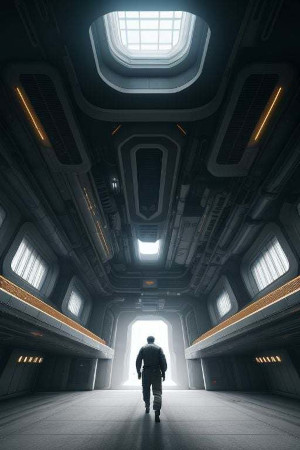2014
Apr
10
A Hierarchy of Gods
149,000 words.
Content advisory: Guns, graphic violence, language, sexual language and situations
Aw! What an adorable pair of little girls!
NOT!
Hold onto your fusion reactor! This is A Hierarchy of Gods, the second installment of The Saga of Banak-Zuur.
It was only freak timing that got college student Lesley Kellerman roped into an intergalactic feud that has lasted 70,000 years and left two unlikely aliens hiding out on Earth, unable to use their advanced technology. Now, the only way out of the predicament seems to be to follow through with an unlikely — possibly insane — plan: steal a deep-space ship from the World Academy, outfit it with technology that does not yet exist on Earth, and secretly launch it to the stars. Right!
But a plan so brazen is bound to attract some unwanted and dangerous attention, from a ruthless scientist whose toes have just been trampled all the way to the Special Operations, the most feared organization in all the World Academy. And perhaps not just on Earth. With attempts on their lives, they must keep a step ahead of powerful forces out to destroy or use them, both those enemies they make on Earth, and the infinitely more dangerous ones from 200,000,000 light-years away. And it might be that their plan, as unlikely as it is, is simply part of a bigger one that was fashioned before humans invented fire.
Will inter-species friendship, trust, and possibly romance survive when death and stranger things are following close behind?
Prologue: Battle in Deep Space
From out of nowhere, the Destructor appeared, flashing up to the side of the tiny coupe like a hovering insect. The size and shape of a silvery football, it attacked without hesitation. It unleashed a third-order particle beam, whose power was equivalent to quadrillions of watts, confident that the coupe could not stand for a millisecond against such energies. But instead, the beam vanished into nothingness a full meter from the coupe’s hull, dissipated into some higher space. Seeing that the first assault failed, the Destructor switched to a beam of superluminal antiparticles, at ten times the power level. But this weapon, though it penetrated perhaps a millimeter farther, was ultimately no more effective.
The Destructor took a moment to consider. Obviously, this tiny coupe of the Trarsani was not as vulnerable as it had assumed, and more finesse, or at least more power, would be necessary.
But in that moment of hesitation, the coupe responded with an attack of its own. It had instantly identified the Destructor as an artifact of The Enemy, and recognized the danger that it therefore represented. One or the other would be exterminated, and the coupe had occupants to protect. It retaliated by placing a third-order singularity in the Destructor’s path, and immediately beyond that, a convolution barrier. Either would annihilate the threat if successful, and the close placement of them was calculated to give the foe no time to react.
But the Destructor had detected the incipient unit field stresses, and responded by phasing past the dangers with a brief excursion outside normal space. In the same act, it extended its own fields in an attempt to construct an artificial space around the coupe where its material portion could not exist.
The Trarsani coupe observed the field transition, and countered it readily. It took advantage of the shift in space-time geometry to construct an artificial space of its own, in the hope that in the midst of the various contortions it would go unnoticed. It burrowed a wormhole through that space, reaching for the innards of the Destructor, planning to release a white hole there and thereby damage — or even vaporize — The Enemy’s mechanisms.
The effort was ineffective. Even worse, the Destructor observed the event immediately and turned the wormhole back on itself. At risk of being destroyed by its own weapon, the coupe dissolved it in a twisting nightmare of space-time continua, discarding the last of its writhing existence into a hidden dimension forever beyond the bounds of the normal universe.
In order to give itself some time to think, the coupe phased out of ordinary space for a few microseconds. When it reappeared, the Destructor observed not one coupe, but a thousand, the others being meticulous reproductions of the original, each displaying the same field signature and each with identical power emissions. Sure enough, the Destructor hesitated as it sought to identify which of the coupes it detected was the real one.
In that time, the coupe launched another attack, one of a multitude of power beams, of every first, second and third order that it could construct, and each at a level of a few hundred terawatts. And not just from itself, but duplicate beams routed through each of the counterfeit images. But the Destructor had third-order technology of comparable or even superior resolution, and was able to not only defend itself, but to use the subtle information contained in those beams to pick out the original coupe.
It counteracted, trying to forge a time loop in the space that the coupe occupied, knowing that it would collapse into a singularity, if not destroying the coupe, at least trapping it in the tiny infinity of a universe isolated for all eternity from this one. Of course the coupe was already monitoring for any attack, particularly ones involving space-time because those could be the most immediately lethal. It escaped through a narrow window, letting the time loop go about its business on its own.
But that gave the coupe an idea. Time. Time was tricky, and subject to severe limitations on how it could be manipulated, and even then only on the order of fractions of a second.
Abruptly, it withdrew some 50,000 miles. The Destructor, mimicking the arrogance of its creators, mistook this action for an attempt to escape, and pursued after it. This error in judgment was the needed opportunity. For the 50,000 miles was to gain not space between them, but time, enough leeway for a reverse time displacement of a hundred milliseconds, as well as the temporal momentum that accompanied it. The coupe unleashed its time displacement field.
The Destructor was not prepared to see this attack coming, since it was looking to the future, not into the past. The thrust of the temporal pulse bumped the Destructor — but not its surrounding zone of space rarefaction — three milliseconds into its own future. In that future, its rarefaction field had already moved ahead by 24 light-years, and the Destructor itself was left traveling in normal space at over 200 billion times the speed of light.
Naturally, this was impossible. The Destructor immediately collapsed into a transcendental singularity, its substance — and therefore its threat — ended. It plowed through the fabric of space-time like a meteorite through a planetary atmosphere, ripping a fissure through it that contracted into a cosmic string dragging behind it like a tail. An instant later, the singularity caught up with the destabilized and contracting rarefaction field, and momentarily became real mass again. The string snapped like a tortured rubber band, and released its unthinkable energies in a flare that threatened to crack the foundations of the universe. Perhaps, centuries in the future, astronomers on developing worlds would mistake it for a supernova, and be puzzled by the lack of accompanying neutrinos.
Finally, the coupe was able to notify its passengers that they had very nearly been killed.
The entire battle had lasted just under three tenths of a second.

















Comments
There are no comments for this post.
You must be logged in to post a comment.